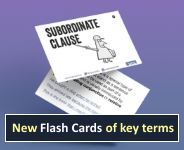Clause types: statements, questions, commands and exclamations
The National Curriculum recognises four clause types (also called ‘sentence types’ ). They are usually used to ‘do different things’. These are statements, questions, commands and exclamations.
Each clause type has its own typical pattern (i.e. word order).
In statements, the Subject comes in its typical position before the verb. Here are some examples:
Welcome back!

Englicious is totally free for everyone to use!
But you will have to log in to see our library of teaching resources.
If you don’t have an account, that’s perfectly OK. You can register (for free).
It only takes a minute or two.
»
- Printer-friendly version
- Log in to view or leave comments

